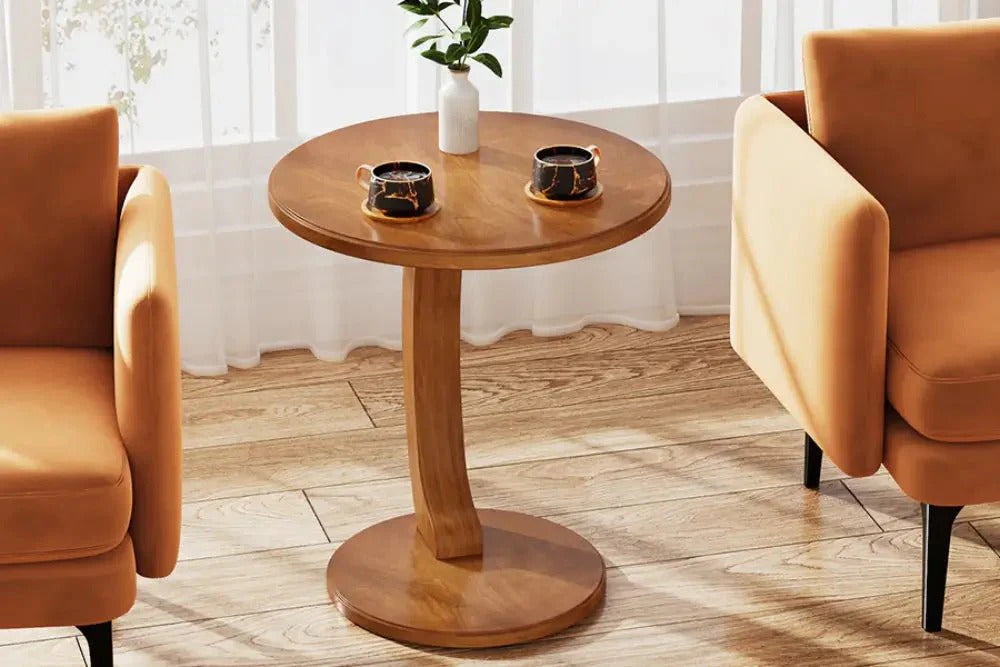Yes, a side table can absolutely work as a bedside table—provided the tabletop sits within ±5 cm of your mattress height. It’s a practical solution for smaller bedrooms (e.g., 2.4 m × 3.0 m) and lighter storage needs, especially when you mainly need space for a lamp, phone, glasses, or a glass of water.
What Is a Side Table?
A side table is a compact, versatile surface that usually sits beside a sofa or lounge chair, keeping everyday essentials—like a lamp, book, remote, or coffee—within easy reach. Most stand around 46–61 cm high with a 41–56 cm round or square top. Some models include a shelf or drawer, while others are purely decorative.
People often use “side table” and “end table” interchangeably in the US, but in Australia the term side table is far more common. In function, a side table typically sits at the end or beside a seating area, offering a balance of practicality and decorative appeal.
Because side tables focus more on accessibility than storage, capacity is limited. A drawer or lower shelf helps, but it won’t replace a full bedside table with dedicated storage. Still, many side tables work perfectly well in the bedroom if the height and surface area suit your needs.

Pros of Using Side Tables as Bedside Tables
- Better height match. Many beds sit around 63–69 cm. A side table at 61–66 cm keeps reach natural. Aim for a height difference of no more than ±5 cm (e.g., 66 cm mattress → 61–71 cm table).
- Smaller footprint. Typical tops are 46–51 cm, smaller than many 56–66 cm-wide bedside tables—great for compact bedrooms. Maintain a minimum 60 cm bedside walkway and keep the table 2–3 cm off the wall for cables.
- More styles at friendlier prices. Side tables commonly fall in the $80–$180 range across timber, metal, and glass designs.
-
Easy to move. Most weigh 5–8 kg, making weekend re-arranging or cleaning straightforward.
Cons of Using Side Tables as Bedside Tables
-
Limited storage. Many side tables don’t have drawers for glasses, medication, chargers, or personal items.
Tip: Add an 20–25 cm bedside basket or a small drawer tray for at least 5–6 small items. - Tight surface space. With 41–46 cm tops, a lamp, phone, mug, and book compete for room.
-
Possible height mismatch.
– ≥8 cm lower than the mattress forces an awkward bend.
– ≥8 cm higher risks elbow bumps when reaching for items. -
Cable clutter. Side tables rarely include cord-management features.
Tip: Use adhesive clips under the table or run cords behind a basket.
Living room tip:
For lounge placement, keep the side table 8–15 cm from the sofa arm and maintain 46 cm of knee clearance.
Bedroom tip:
Match table height to mattress within ±5 cm, and aim for a combined lamp + table height of 147–163 cm for comfortable nighttime reading.

Side Table vs Bedside Table
Side tables and beside tables are both essential pieces of furniture, though they differ in use and design. Below is a detailed comparison:
Feature Comparison
| Feature | Side Table | Bedside Table |
| Typical Height | 46–61 cm | 61–71 cm |
| Design Focus | Decoration & utility in living areas | Storage & practicality for bedrooms |
| Storage | Often open shelves or small drawers | Usually includes drawers or concealed storage |
| Placement | Next to sofas, lounge chairs | Beside the bed |
| Surface Area | Smaller surface for lamps & décor | Larger surface for night-time essentials |
| Function | Holds drinks, décor, remotes | Holds lamps, books, alarms, personal items |
| Aesthetic Style | Versatile across modern/rustic/minimalist | Typically matches bedroom furniture |

Conclusion
Side tables and bedside tables both serve important roles, but the right choice depends entirely on your space and storage needs. Whether you're looking for a versatile piece for your living room or a functional surface for your bedroom, it’s essential to consider the purpose, available room, and the overall design of your home.
At Tribesigns, we offer a wide range of side tables and bedside tables designed to suit various styles, layouts, and budgets. Let us help you find the perfect piece that blends practicality with aesthetic appeal.
FAQ
Are Bedside Tables and Side Tables the Same Size?
Not exactly. Bedside tables prioritise height alignment—usually 61–71 cm high and 41–51 cm deep. Side tables generally run 46–61 cm high and may be as shallow as 41–46 cm.
What Else Can You Use Side Tables For?
Side tables are incredibly versatile and can serve several functions beyond the living room. Here are a few popular Australian uses:
- Plant Stand: Side tables make great stands for indoor plants—just ensure the table is sturdy enough for the pot’s weight.
- Entryway Catch-All: Perfect for keys, mail, wallets, and everyday essentials. Choose one with a drawer or lower shelf, and add a tray to keep everything organised.
- Mini Printer Station: A compact printer fits easily on many side tables, ideal for home offices needing just a little extra surface space.
- Reading Nook Side Table: Place a side table beside a comfy armchair to hold books, glasses, or a cuppa.
Where Should Side Tables Be Placed in the Living Room?
Placement affects both function and room flow. Here are the most effective options:
- Beside a sofa or lounge chair: This keeps drinks, remotes, and lamps within easy reach.
- At the end of a seating area: Keeps the space open and avoids blocking sight lines.
- Away from high-traffic walkways: Prevents bumping and keeps pathways clear.
- In front of a window (optional): Ideal for displaying décor or adding soft lighting—but avoid placing delicate items in direct sunlight.
By following these guidelines, you can create a convenient and stylish side-table layout that enhances your living space while keeping it functional and easy to navigate.



